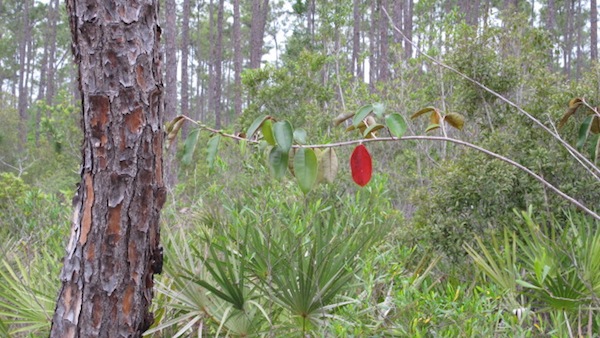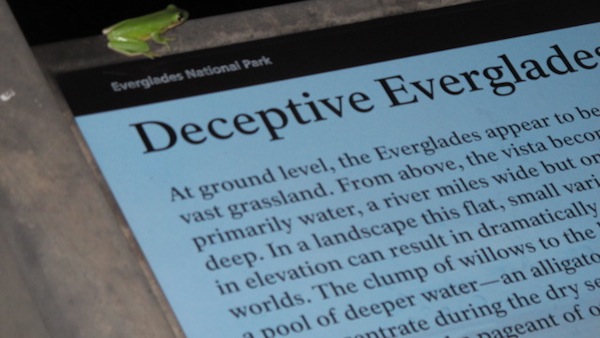
AIRIE March 2014 update
By Nathaniel Sandler, AIRIE fellow
Living alone in the swamp is like playing a role in a silent film except that the music is not Benny Hill; it is the constant murmuring hum of whatever beast lies afoot and in earshot. Were it actually a silent film maybe you’d run into Buster Keaton, but there are not many other people out here aside from park employees you barely know and the tourists who you never will. Over the sound of you not talking to anyone, there is noise, plenty of it. Birds and bugs are the biggest culprits, but I can tell you that in March on the overlook of Anhinga Trail the alligators are lying in droves – sometimes crisscrossed on top of each other –and at night they loudly bellow like the hungry, lustful ancient beasts they are.
In her crucial book Swamplife, FIU anthropologist Laura Ogden claims that, “the Everglades, as we know it, has always been entangled at the intersection of the human and nonhuman worlds.” Of course Ogden is referring to the human element on the landscape, which through mostly subtle manipulation goes as far back as prehistory. Dredging may be a 20th century demon, but all who have lived here, dating back to the Calusa have carved up the muck in their visage. Or at least tried to.
I have spent a month here as the AIRIE Artist in Residence in the Everglades and have thought about Ogden’s statement on countless different levels. I am interested in the “nonhuman world”, a phrase fully loaded with all of the delicious things that a writer can smear on a cracker. It could be animals, vegetables, or ghosts. Each day is spent trudging along with a faux pioneering spirit as homage to early settlers of this land looking for clues. For animals and other things.
Writers, as some of you may know, have recently begun choosing the swamp more and more to create non-human worlds. Karen Russell’s Swamplandia! immediately comes to mind, a beautifully told magical realist tale of the Florida swamp about the bizarre troubles of a carnie family. The swamp holds America’s fervent gaze on television, True Detective being the most recent and widespread example, but also True Blood’s vampires lined up against countless reality TV shows like Swamp People, (History Channel), Swamp Loggers (Discovery Channel), Swamp Murders (Investigation Discovery), Swamp Men (Nat Geo Wild), Swamp Wars (Animal Planet) etc.
There is mystery here and with mystery follows fascination.
Earlier in the week and late into the night I saw camera flashing in the distance. It was an odd feeling. What in the @#$% is a camera flashing out here now!? The park employees who live nearby couldn’t possibly be outside taking pictures at this hour. The rain was pattering down steadily enough to stay inside and I had drunk a single sleepy beer. There was no thunder, no lightening before or after. They were quick enough together and too bright, too close. I began to run through a series of possibilities. Murder, psychopath, voyeur, and deviant: all the good stuff. It was an uneasy sleep and I think just being here created exceedingly fervent and paranoid images.
Part of my work in the Everglades has been in the archive of the park itself. Many people don’t know that there is a massive collection of physical objects in museum storage that the park keeps as a repository for the five major Southeast Florida collections – Everglades, Big Cypress, Biscayne National, DeSoto, and the Dry Tortugas. I have seen Dr. Mudd’s cane, full swords from Spanish shipwrecks, swamp tchotchkes from the time your grandparents visited, and the wallet of the notoriously assassinated game warden Guy Bradley. They all sit comfortably next to every kind of taxidermy, hide, and skull, filed across from plant samples, butterflies on pins, and tens of thousands of tree snail specimens. It is the physical manifestation of Ogden’s suggestion, human and non-human intersection, hardily encased for future generations.
After those ominous camera flashes, I spend the next day trudging through numerous acid free boxes holding 50 years of documents relating to the Florida Panther Recovery Program. The literally thousands of pages show a history of the arduous and exceedingly complex task of preserving our most rare local land mammal. This is again what Ogden means when she talks about the intersection of human and nonhuman: the panther and the people who have spent their lives trying to either save the big cat from extinction or shoot it. Indeed the history of not just the Panther, but the whole of the Everglades is long and intricate with countless decisions being made all the time. At this point, even inactions have become decisions for better or worse.
Digging through the paperwork I noticed some panther sightings had been caught decades before and made further reference to some more recent photographs in another. Motion sensor cameras. Of course. That’s what the flashing outside my window the night before was. There must be tons of them.
I didn’t pull the slides. The reason for this is complicated, and perhaps boring, but they would have required pulling a different box, and I had already looked at countless vague images of panthers, their tracks, and read about even more sightings. And when there’s 18 boxes to go through you have to pick your battles.
But in hindsight I’d like to imagine it as respect. It’s a false projection, but thinking back on the whole incident that harmless wrong becomes coupled with another; a childish hope and the fancy of real live Florida panther caught by one of the many motion sensor activated cameras set up throughout the park. Right outside my window he stalked, with a cautious majesty. I imagine that he was coming to check up on me, to watch over me, in intersection.

Recent Content
-
Artsarticle ·
-
Artsarticle ·
-
Artsarticle ·
